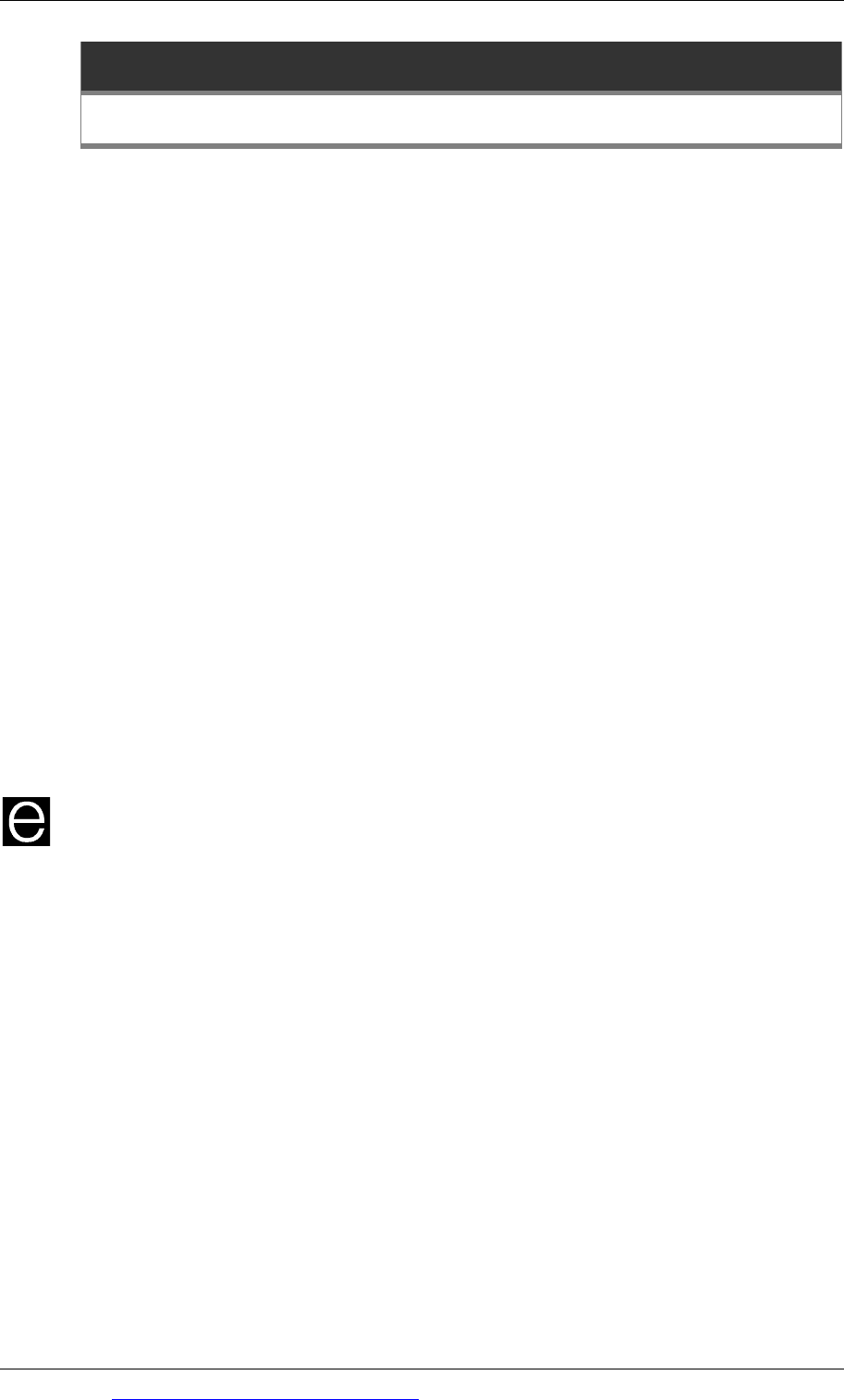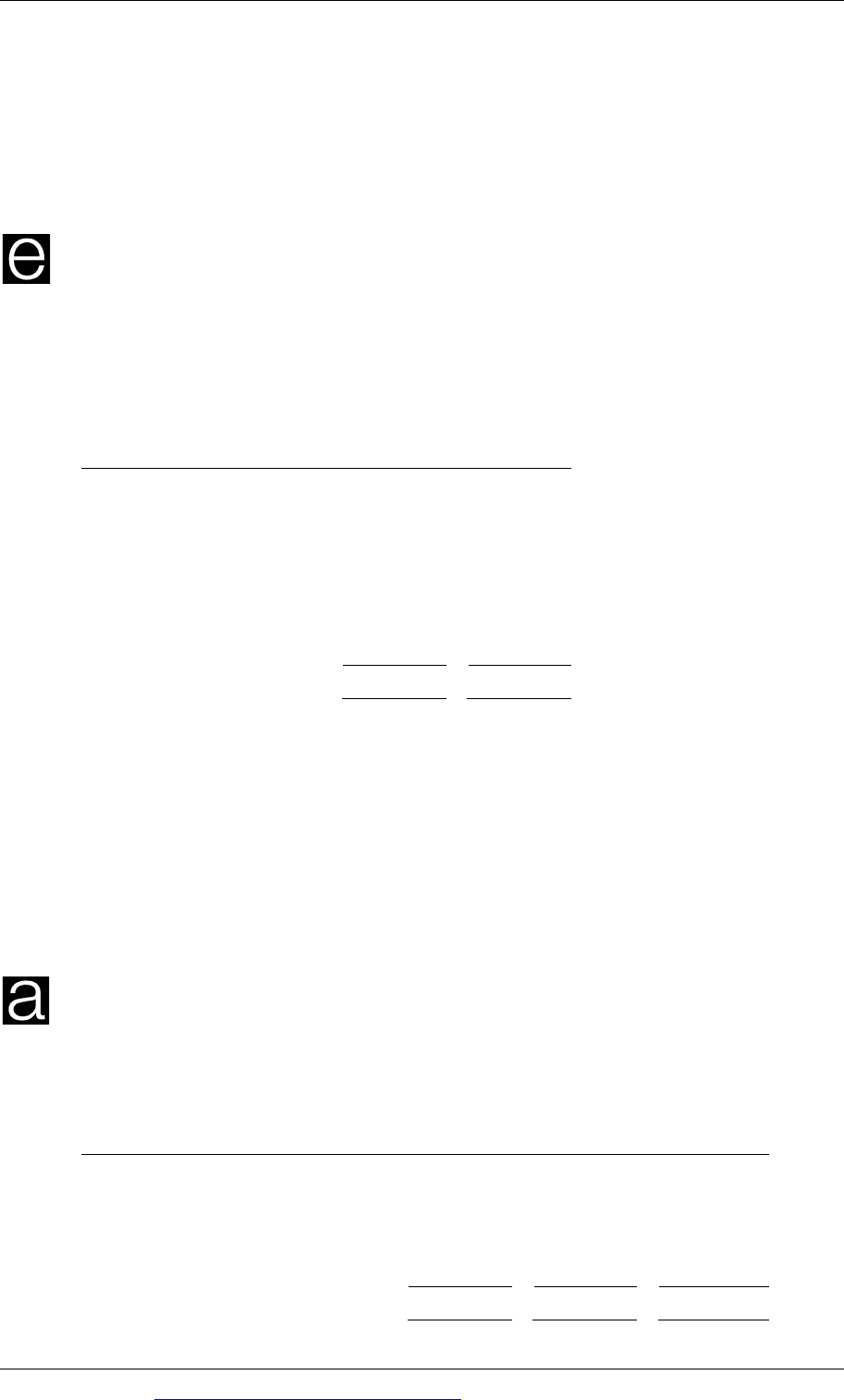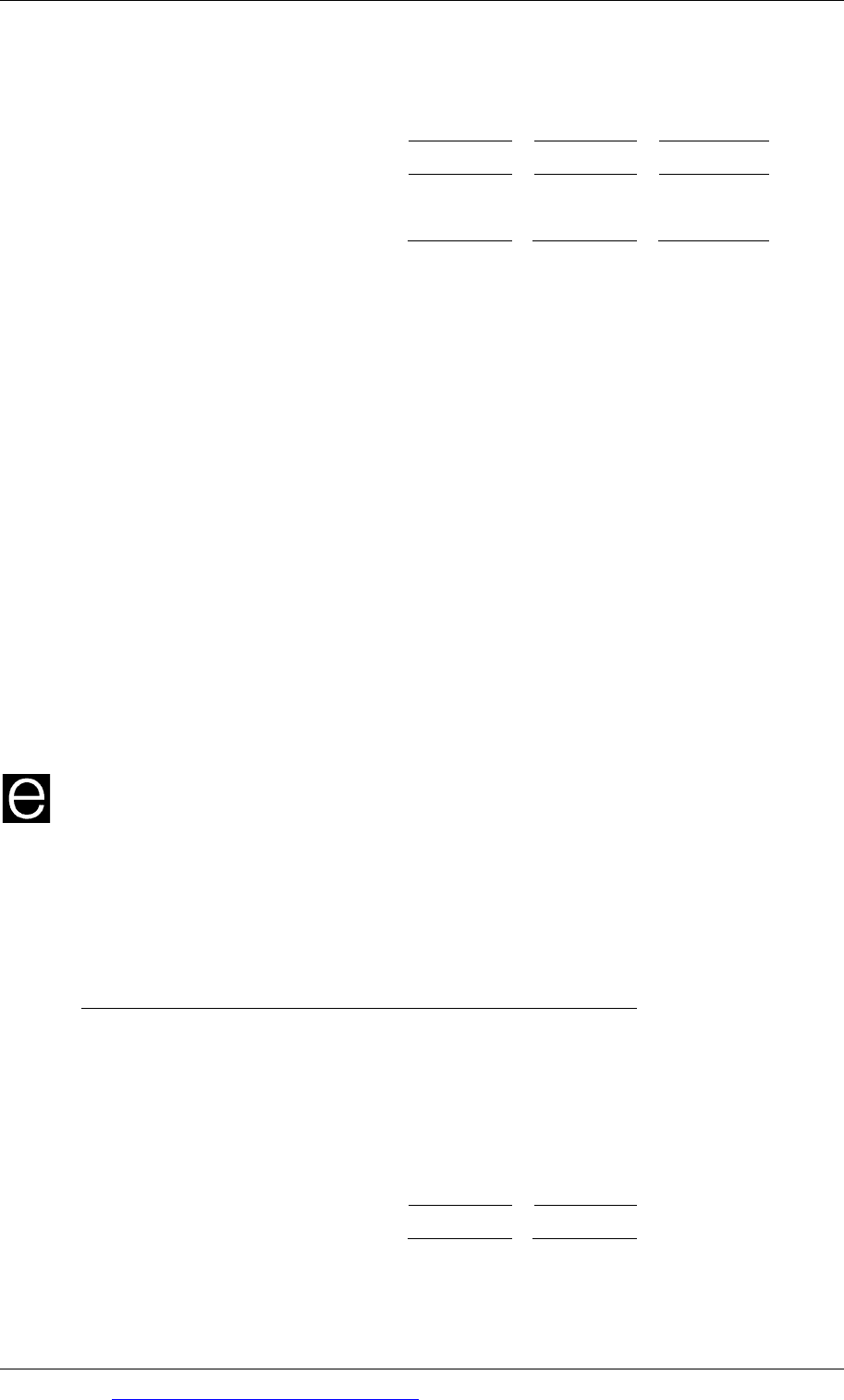ACCA F5 Performance Management - 2010 - Study text - Emile Woolf Publishing
Подождите немного. Документ загружается.


Chapter 13: Divisional performance
© EWP Go to www.emilewoolfpublishing.com for Q/As, Notes & Study Guides 355
Required:
Compare the performance of the two divisions using:
(a)
ROI
(b)
Residual income.
Answer
Big
Small
Profit $900,000
$90,000
Net assets $8 million
$400,000
ROI 11.25%
22.5%
$
$
Profit 900,000
90,000
Notional interest 800,000
40,000
Residual income 100,000
50,000
Using ROI as a measure of performance, Small Division has performed better than
Big Division. However Big Division has made a higher residual income, and it could
therefore be argued that it has performed better than Small Division.

Paper F5: Performance management
356 Go to www.emilewoolfpublishing.com for Q/As, Notes & Study Guides © EWP
Divisional performance and depreciation
ROI or RI: the problem with depreciation
4 Divisional performance and depreciation
4.1 ROI or RI: the problem with depreciation
If straight-line depreciation is used and capital employed is based on carrying
values (net book values) the annual ROI and residual income will increase over time
if:
annual profits are constant, and
assets are not replaced, and existing assets remain in use as they get older.
In the early years of an investment, the ROI or residual income may be very low. If a
divisional manager is concerned about the effect that this would have on the
division’s ROI or residual income for the next year or two, the manager may refuse
to invest in the project. This is because performance in the next year or so might be
much worse, even though the project might be expected to earn a high return over
its full economic life.
The tendency for ROI and residual income to increase over time if assets are not
replaced means that divisional managers may prefer to keep old and ageing assets
in operation as long as possible – even though it might be preferable in the longer
term to replace the assets sooner.
Example
A company has just opened a new division that will operate as an investment
centre. The following estimates of future performance have been made.
The division requires an investment of $5 million. This consists entirely of new non-
current assets. Non-current assets will be depreciated at the rate of 25% of cost each
year, and there will be no residual value after four years.
Sales revenue in the first year will be $10.8 million, but in subsequent years will
change as follows:
(1)
There will be no change in selling prices in Year 2, but prices will be reduced
by 5% in Year 3 and by a further 5% in Year 4.
(2)
Sales volume will increase by 10% in Year 2 and a further 10% in Year 3, but
sales volume in Year 4 will be the same as in Year 3.

Chapter 13: Divisional performance
© EWP Go to www.emilewoolfpublishing.com for Q/As, Notes & Study Guides 357
Costs estimates are as follows.
(1)
Gross profit will be 40% in Year 1, but will change as prices are reduced in
Years 3 and 4.
(2)
There will be no change in the cost of sales per unit sold: prices per unit for
cost of goods sold will remain stable.
(3)
Annual overheads including depreciation will be $3.5 million in Year 1 and
Year 2 and $4 million in Years 3 and 4.
Required
Calculate for each of years 1 – 4: residual income each year
(a) Sales revenue
(b) Gross profit
(c) Net profit
(d) ROI, assuming that capital employed is the net book value of the investment
in the division as at the beginning of the year.
Comment on the figures.
Year 1
Year 2
Year 3 Year 4
$m
$m
$m $m
Sales revenue (working 1) 10.800
11.880
12.415 11.794
Cost of sales (working 2) 6.480
7.128
7.841 7.841
Gross profit 4.320
4.752
4.574 3.953
Overheads 3.500
3.500
4.000 4.000
Net profit/(loss) 0.820
1.252
0.574 (0.047)
Net assets at beginning of
year
5.00
3.75
2.50 1.25
ROI 16.4%
33.4%
23.0% (1.3)%
Gross profit margin 40.0%
40.0%
36.8% 33.5%
Net profit margin 7.6%
10.5%
4.6% 0%
Workings
(1) Sales revenue = Revenue in previous year × Price change × Sales volume
change
Year 2: $10.8 million
× 100% × 1.10 = $11.88 million
Year 3: $11.88 million
× 95% × 1.10 = $12.4146 million, say $12.415 million
Year 4: $12.4146 million
× 95% × 1.0 = $11.79387 million, say $11.794 million.
(2)
Cost of sales = 60% of sales in Year 1. The total cost of sales will then vary
each year with changes in sales volume.

Paper F5: Performance management
358 Go to www.emilewoolfpublishing.com for Q/As, Notes & Study Guides © EWP
Year 1: Cost of sales = 60% × $10.8 million = $6.48 million
Year 2: Cost of sales = $6.48 million
× 1.10 = $7.128 million
Year 3: Cost of sales = $7.128 million
× 1.10 = $7.8408 million, say $7.841
million.
Year 4: Same as Year 3 (no change in sales volume).
(3)
Net assets: $5 million at the beginning of Year 1, reducing by (25%) $1.25
million in each subsequent year.
Analysis
There is a tendency for ROI to increase as non-current assets get older. This is most
apparent in Year 2, when ROI increases from 16.4% to 33.4%, largely because of the
reduction in the value of the investment in the division. ROI would also increase in
Year 3 and Year 4, but the effect of changes in selling prices and overhead costs
mean that the net effect is a reduction in ROI in those years (and also in the gross
profit and net profit margins).
ROI is affected in Year 3 by the first 5% fall in sales and the increase in overhead
costs by $500,000. In Year 4, performance gets worse, in spite of the fall in net assets
to $1.25 million, because of the further fall in sales prices and gross profit margin. In
year 4 there is even a small net loss.

© EWP Go to www.emilewoolfpublishing.com for Q/As, Notes & Study Guides 359
Paper F5
Performancemanagement
CHAPTER
14
Transfer pricing
Contents
1 Transfer pricing: purpose and objectives
2 Problems with transfer pricing
3 Transfer pricing in practice

Paper F5: Performance management
360 Go to www.emilewoolfpublishing.com for Q/As, Notes & Study Guides © EWP
Transfer pricing: purpose and objectives
Purpose of transfer pricing
Definition of a transfer price
Transfers at cost
Transfer pricing at cost plus
Transfer pricing at market price
The objectives of transfer pricing
1 Transfer pricing: purpose and objectives
1.1 Purpose of transfer pricing
When a company has a divisionalised structure, some of the divisions might supply
goods or services to other divisions in the same company.
One division sells the goods or services. This will be referred to as the ‘selling
division’.
Another division buys the goods or services. This will be referred to as the
‘buying division’.
For accounting purposes, these internal transfers of goods or services are given a
value. Transfers could be recorded at cost. However, when the selling division is a
profit centre or investment centre, it will expect to make some profit on the sale.
1.2 Definition of a transfer price
A transfer price is the price at which goods or services are sold by one division
within a company to another division in the same company. Internal sales are
referred to as transfers, so the internal selling and buying price is the transfer price.
When goods are sold or transferred by one division to another, the sale for one
division is matched by a purchase by the other division, and total profit of the
company as a whole is unaffected. It is an internal transaction within the company,
and a company cannot make a profit from internal transfers.
A decision has to be made about what the transfer price should be. A transfer price
may be:
the cost of the item (to the selling division), or
a price that is higher than the cost to the selling division, which may be cost plus
a profit margin or related to the external market price of the item transferred.

Chapter 14: Transfer pricing
© EWP Go to www.emilewoolfpublishing.com for Q/As, Notes & Study Guides 361
1.3 Transfers at cost
The transfer price may be the cost of making the item (goods) or cost of provision
(services) to the selling division. A transfer at cost may be at either:
marginal cost (variable cost), or
full cost.
Example
An entity has two divisions, Division A and Division B. Division A makes a
component X which is transferred to Division B. Division B uses component X to
make end-product Y. Details of budgeted annual sales and costs in each division are
as follows:
Division
A
Division
B
Units produced/sold 10,000 10,000
$
$
Sales of final product -
350,000
Costs of production
Variable costs 70,000
30,000
Fixed costs 80,000
90,000
Total costs 150,000
120,000
Required
What would be the budgeted annual profit for each division if the units of
component X are transferred from Division A to Division B:
(a) at marginal cost
(b) at full cost?
How would the reported profit differ if actual sales prices, actual variables costs per
unit and total fixed costs were as budgeted, but units sold are 10% more than
budget?
Answer
Transfers at marginal cost: budgeted performance:
Division
A
Division
B
Company
as a
whole
Units produced/sold 10,000 10,000 10,000
$
$
$
External sales of final product -
350,000
350,000
Internal transfers (10,000 × $7)
70,000
-
0
Total sales 70,000
350,000
350,000

Paper F5: Performance management
362 Go to www.emilewoolfpublishing.com for Q/As, Notes & Study Guides © EWP
Costs of production
Internal transfers (10,000 × $7)
-
70,000
0
Other variable costs 70,000
30,000
100,000
Fixed costs 80,000
90,000
170,000
Total costs 150,000
190,000
270,000
Profit/(net cost or loss) (80,000)
160,000
80,000
For the company as a whole, the internal transfers are not included in sales and
costs. The transfers affect the financial results of the divisions.
By transferring goods at variable cost, the transferring division earns revenue equal
to its variable cost of production. It therefore bears the full cost of its fixed costs, and
its records a loss (or a net cost) equal to its fixed costs.
On the other hand, the buying division (Division B) reports a profit. Because te fixed
costs of Division A are not included in the transfer price, the profit of Division B
exceeds the total profit of the company as a whole.
Transfers at marginal cost: actual sales higher than budget
The same situation occurs if actual output and sales differ from budget. If
production and sales are 11,000 units, the profits of Division B will increase, but
Division A still makes a loss equal to its fixed costs. The total company profits
increase by the same amount as the increase in the profits of Division B.
Division
A
Division
B
Company
as a
whole
Units produced/sold 11,000 11,000 11,000
$
$
$
External sales of final product -
385,000
385,000
Internal transfers (11,000 × $7)
77,000
-
0
Total sales 77,000
385,000
385,000
Costs of production
Internal transfers (11,000 × $7)
-
77,000
0
Other variable costs 77,000
33,000
110,000
Fixed costs 80,000
90,000
170,000
Total costs 157,000
200,000
280,000
Profit/(net cost or loss) (80,000)
185,000
105,000

Chapter 14: Transfer pricing
© EWP Go to www.emilewoolfpublishing.com for Q/As, Notes & Study Guides 363
Transfers at full cost: budgeted performance:
In this example, the full cost per unit produced in Division A is $15, with an
absorption rate for fixed overheads of $8 per unit produced and transferred.
Division
A
Division
B
Company
as a
whole
Units produced/sold 10,000 10,000 10,000
$
$
$
External sales of final product -
350,000
350,000
Internal transfers (10,000 × $15)
150,000
-
0
Total sales 150,000
350,000
350,000
Costs of production
Internal transfers (10,000 × $15)
-
150,000
0
Other variable costs 70,000
30,000
100,000
Fixed costs 80,000
90,000
170,000
Total costs 150,000
270,000
270,000
Profit 0
80,000
80,000
Since the transfer price includes the fixed costs of the selling division, Division A is
able to cover all its costs, but it reports neither a profit nor a loss. It covers its costs
exactly.
The buying division (Division B) has to pay for the fixed costs of division A in the
transfer price. It still reports a profit, but this profit is now equal to the profit earned
by the company as a whole.
Transfers at full cost: actual sales higher than budget
A similar situation occurs if actual output and sales differ from budget. If
production and sales are 11,000 units, the profits of Division B will increase.
However, Division A will make some ‘profit’, but this is simply the amount by
which its fixed overhead costs are over-absorbed.
Division
A
Division
B
Company
as a
whole
Units produced/sold 11,000 11,000 11,000
$
$
$
External sales of final product -
385,000
385,000
Internal transfers (11,000 × $15)
165,000
-
0
Total sales 165,000
385,000
385,000
Costs of production

Paper F5: Performance management
364 Go to www.emilewoolfpublishing.com for Q/As, Notes & Study Guides © EWP
Internal transfers (11,000 × $15)
-
165,000
0
Other variable costs 77,000
33,000
110,000
Fixed costs (incurred) 80,000
90,000
170,000
Total costs 157,000
288,000
280,000
Profit 8,000
97,000
105,000
These examples should illustrate that if transfers are at cost, the selling division has
no real incentive, because it will earn little or no profit from the transactions. In
effect, the selling division is a cost centre rather than a profit centre or investment
centre.
1.4 Transfer pricing at cost plus
For the purpose of performance measurement and performance evaluation in a
company with profit centres or investment centres, it is appropriate that:
the selling division should earn some profit or return on its transfer sales to
other divisions and
the buying division should pay a fair transfer price for the goods or services that
it buys from other divisions.
One way of arranging for each division to make a profit on transfers is to set the
transfer price at an amount above cost, to provide the selling division with a profit
margin. However the transfer price should not be so high that the buying division
makes a loss on the items it obtains from the selling division.
Example
An entity has two divisions, Division C and Division D. Division C makes a
component Y which is transferred to Division D. Division D uses component Y to
make end-product Z. Details of budgeted annual sales and costs in each division are
as follows:
Division
C
Division
D
Units produced/sold 10,000 10,000
$
$
Sales of final product -
350,000
Costs of production
Variable costs 70,000
30,000
Fixed costs 80,000
90,000
Total costs 150,000
120,000
